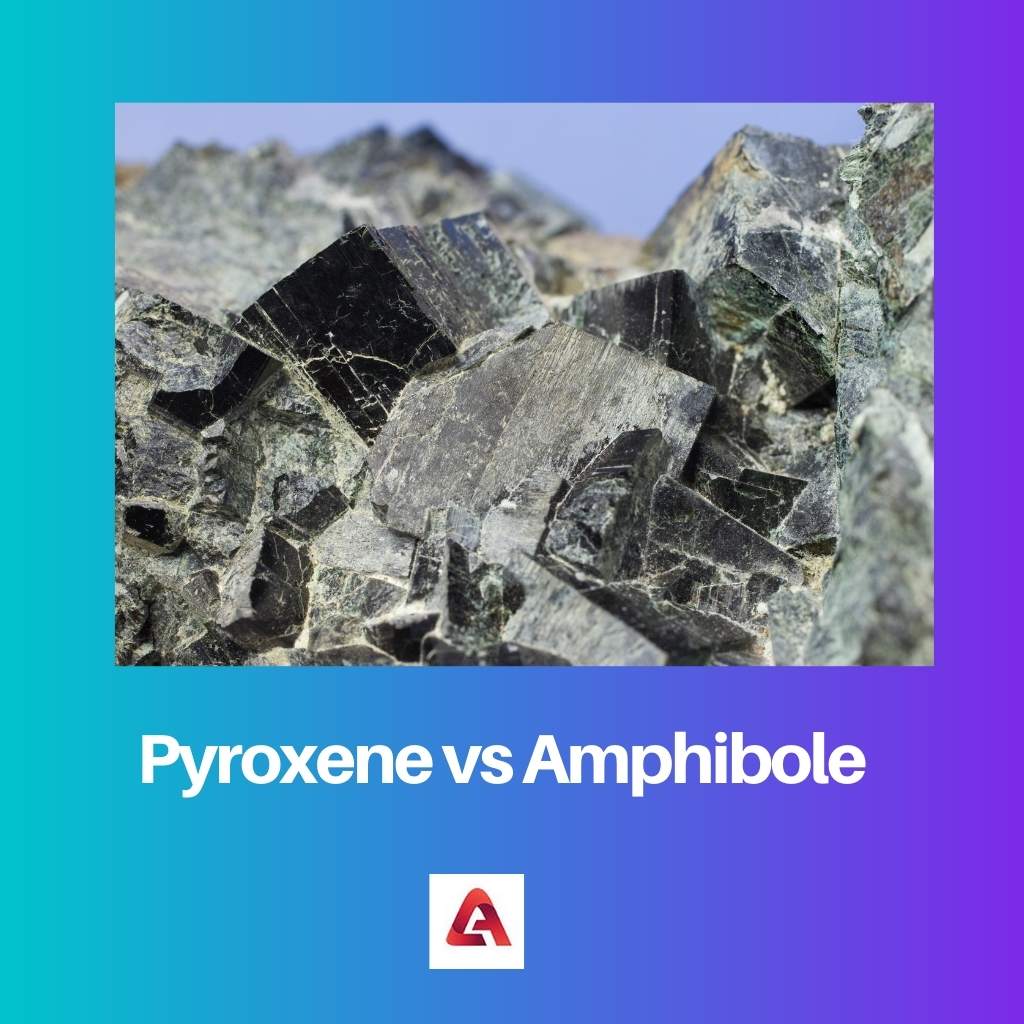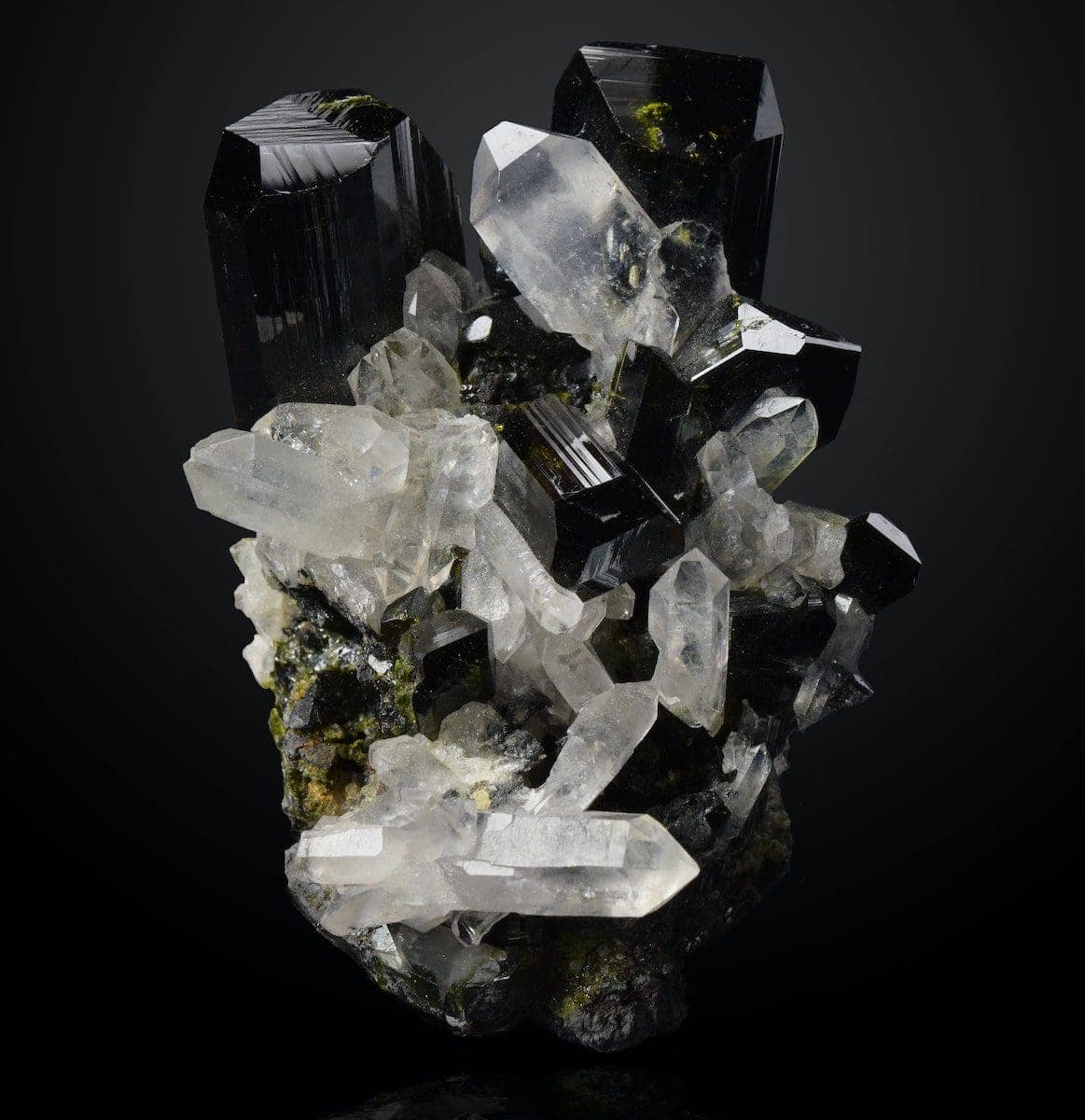Several kinds of rocks consist of minerals that had used for several purposes. Metamorphic contains different minerals, and those rocks had used for suitable purposes. Pyroxene and Amphibole are minerals that contain in metamorphic rocks.
Key Takeaways
- Pyroxene is a group of dark-colored, silicate minerals that crystallize in a single chain of tetrahedrons.
- Amphibole is a group of dark-coloured, silicate minerals that crystallize in a double chain of tetrahedrons.
- Pyroxene and amphibole are common rock-forming minerals in igneous and metamorphic rocks but have different crystal structures and chemical compositions.
Pyroxene vs Amphibole
Pyroxene is a type of mineral that can be used in the formation of rocks. Metamorphic rocks contain pyroxene minerals. The abbreviation used for pyroxene is ‘Px.’ Amphibole is a mineral that can be found in igneous rocks. There are two types of crystal structures in amphiboles. Amphibole stones can be used in the construction of roads.

Pyroxene is a mineral found in metamorphic rocks. The pyroxene minerals had found in igneous and metamorphic rocks. Pyroxene is a large class of rocks that forms silicate minerals and contains calcium, magnesium, and iron.
Pyroxene had mainly materialized as prismatic crystals. Pyroxene had abbreviated as Px, where a group of minerals forming in an igneous and metamorphic rock.
Amphibole is a group of inosilicate minerals that materialize in prisms and needle-like crystals. Amphibole contains a chain of SiO4 tetrahedra molecules.
Amphibole consists of iron ions and magnesium ions in the structure of the Amphibole crystals. Amphibole had available in different types of colours.
Comparison Table
| Parameters of Comparison | Pyroxene | Amphibole |
|---|---|---|
| Meaning | Pyroxene is the inosilicate minerals that form in metamorphic rocks. | Amphibole is a group of inosilicate minerals contains in igneous and metamorphic rocks. |
| Minerals | Pyroxene obtains silicate minerals, calcium, iron ions and magnesium ions. | Amphibole consists of minerals like aluminium silicate, sodium ions, iron ions, magnesium and tetrahedra ions. |
| Structure | Pyroxene accommodates Octahedral layers that contain marked cations like M1 and M2. | Amphibole appears in two different crystal structure. Monoclinic and Orthorhombic are the structures of Amphibole. |
| Colours | Depending on the chemical process, the Pyroxene can turn from dark green to black colour, turn into apple green and from lilac to colourless. | Depending on the chemical compositions, Amphibole can turn colourless to green, white, brown, black, blue or lavender. |
| Properties | Pyroxene consists of 5-6 of solidity, specific gravity up to 3.2-3.9, cleavage planes. Have crystal structure and Lustre. | Amphibole consists of 5-6 of solidity, specific gravity up to 2.9-3.2. Elongate habit and two directions of cleavage are the main properties. |
What is Pyroxene?
Pyroxene is an inosilicate mineral that forms on igneous and metamorphic rocks. Pyroxene is a large class of rocks that form silicate minerals and contains calcium, magnesium, and iron.
Pyroxene had mainly materialized as prismatic crystals. Pyroxene had abbreviated as Px, where a group of minerals forms in Igneous, metamorphic rock.
The Chemical formula of Pyroxene is XY(Si, Al)2SO2. Where X constitutes calcium, sodium, magnesium, iron (II), lithium, and manganese, Y constitutes smaller-size ions such as chromium, magnesium, cobalt, iron (II), aluminum, manganese, scandium, titanium, vanadium, and iron.
There may exist so many kinds of pyroxenes, such as magnesium-iron pyroxenes, calcium-sodium pyroxenes, sodium pyroxenes, calcium pyroxenes, and lithium pyroxenes. Pyroxene accommodates Octahedral layers where those layers had marked as M1 and M2.
Depending on the chemical process, the Pyroxene can turn from dark green to black colour, turn into apple green, and from lilac to colourless. Properties of Pyroxene had it consists of 5-6 of solidity, specific gravity up to 3.2 to 3.9, cleavage planes, Lustre, and crystal structure.
The minor and secondary compositions of Pyroxene are used as the crushed stone and dimension stone.

What is Amphibole?
Amphibole is one of the inosilicate mineral rocks located on igneous and metamorphic rocks. An amphibole is a group of inosilicate minerals that materialize in prisms and needle-like crystals.
Amphibole contains a chain of (SiO)4 tetrahedra molecules. (X)7Si8O22(OH)2 is the main chemical formula of the Amphibole, where X represents iron, magnesium, and calcium.
Amphibole consists of minerals like aluminum silicate, sodium ions, iron ions, magnesium, and tetrahedra ions. (X)7Si8O22(OH)2 is the main chemical formula of the Amphibole, where X represents iron, magnesium, and calcium.
Amphibole appears in two different crystal structures. Monoclinic and Orthorhombic are the structures of Amphibole. Depending on the chemical composition, Amphibole can turn colourless to green, white, brown, black, blue, or lavender.
Properties of the Amphibole are 5 to 6 of hardness, 2.9 to 3.2 of specific gravity, two directions of cleavage planes such intersects 59 degrees and 120 degrees, and broadened habit.
Amphibole rocks had used as paving stones and slightly facing on the buildings as interior parts or exterior parts. An Amphibole had mainly used as crushed stones that helped in constructing roads and railroads.

Main Differences Between Pyroxene and Amphibole
- Pyroxene is an inosilicate mineral used on rocks, whereas Amphibole is also an inosilicate mineral that forms on igneous and metamorphic rocks.
- Pyroxene can find in prismatic crystals, whereas Amphibole can appear in prisms and needle-like crystals.
- Pyroxene accommodates Octahedral layers where Amphibole appears Monoclinic and Orthorhombic in structure.
- The Chemical formula of Pyroxene is XY(Si, Al)2 SO2, where X and Y represent various ions. On the other way out, (X)7Si8O22(OH)2 is the main chemical formula of the Amphibole, where X represents iron, magnesium, and calcium.
- Pyroxene can turn from dark green to black colour, turn into apple green, and from lilac to colourless, whereas Amphibole can turn colourless to green, white, brown, black, blue, or lavender.
- Pyroxene contains a single chain of tetrahedra ions. On the other hand, Amphibole consists of a double chain of tetrahedra ions.

- https://www.sciencedirect.com/science/article/pii/001670378190065X
- https://link.springer.com/content/pdf/10.1007/BF00371882.pdf
- https://link.springer.com/content/pdf/10.1007/BF00636515.pdf

This article offers a comprehensive exploration of Pyroxene and Amphibole, encompassing their distinctive features, structures, and uses. It’s an insightful piece that sheds light on the geological relevance of these minerals.
Absolutely, Sasha15. The article’s thorough examination of Pyroxene and Amphibole provides readers with an in-depth understanding of their geological significance. It’s a valuable resource for anyone enthusiastic about geology.
The detailed information on Pyroxene and Amphibole, along with the comparison table, is highly beneficial for gaining insights into these minerals. It’s a meticulously written article that elucidates their geological relevance.
I concur with Chall. The article’s presentation of Pyroxene and Amphibole is remarkable. The detailed examination of their properties and uses is commendable, offering a comprehensive understanding of these minerals.
The article provides a well-structured analysis of Pyroxene and Amphibole, presenting their respective structures and properties lucidly. The comparison table offers a precise overview of these minerals, making it a valuable read.
The article’s thorough examination of Pyroxene and Amphibole, complemented by the detailed comparison table, serves as an invaluable resource for understanding these minerals. It’s a comprehensive and informative piece for geology enthusiasts.
Absolutely, Mike Evans. The article’s elucidation of Pyroxene and Amphibole’s properties and applications is impressive. It provides a comprehensive understanding of these minerals’ geological relevance.
I couldn’t agree more. The detailed comparison between Pyroxene and Amphibole, along with the explanation of their chemical compositions, makes this article an invaluable read for those interested in geology.
The detailed examination of Pyroxene and Amphibole, including their chemical compositions, structures, and properties, contributes significantly to our understanding of these minerals. This article is a valuable resource for those seeking in-depth knowledge of geology.
The article’s elucidation of Pyroxene and Amphibole is exemplary. The chemical formula and comparison table offer a comprehensive understanding of these minerals, making it an informative read for those interested in geology.
Absolutely. The detailed comparison table aids in easily comprehending the differences between Pyroxene and Amphibole. The article provides valuable and thorough insights into the characteristics and applications of these minerals.
The article presents a comprehensive overview of Pyroxene and Amphibole, including their distinct characteristics and properties. It’s well-structured and provides valuable information for individuals interested in the geological sciences.
Indeed, the article’s emphasis on the comparison between Pyroxene and Amphibole is highly beneficial. The detailed insights into their respective compositions and applications serve as an excellent reference for those studying geological formations.
The article’s detailed insights into Pyroxene and Amphibole are commendable. Its meticulous comparison of their properties and structures serves as an excellent source of knowledge for individuals interested in geology.
The comparison table and detailed analysis of Pyroxene and Amphibole are exceptionally informative. This article provides a thorough understanding of these minerals, catering to the intellectual curiosities of geology enthusiasts.
I completely agree. The article’s comprehensive breakdown of Pyroxene and Amphibole is highly informative, deepening our knowledge of these minerals and their geological significance.
The article’s comprehensive breakdown of Pyroxene and Amphibole is truly enlightening. The detailed comparison of their chemical properties, structures, and practical uses provides invaluable knowledge for those with an interest in geology.
I couldn’t agree more. The chemical formula of Pyroxene and the crystal structures of Amphibole are effectively explained in this article, contributing to a deeper understanding of these minerals and their geological significance.
The detailed exploration of Pyroxene and Amphibole and their comparison table offer a comprehensive understanding of these minerals. This article is an excellent resource for individuals looking to deepen their knowledge of geological formations.
Indeed, the article’s thorough examination of Pyroxene and Amphibole enhances our understanding of these minerals. The comparison table contributes significantly to the cohesive portrayal of their distinctive features and applications.
I concur with Turner Jeremy. The in-depth analysis of Pyroxene and Amphibole provides valuable insights into their properties and geological uses. It’s a commendable and enlightening piece.
The article’s detailed comparison of Pyroxene and Amphibole provides valuable insight into these two types of minerals and their respective uses in igneous and metamorphic rocks. Its chemical formula is very informative and useful for understanding its composition. I appreciate the depth and thoroughness of the information provided.
I agree! The specific comparative analysis allows for a better understanding of the practical applications of Pyroxene and Amphibole, as well as their distinguishing features. It’s a very enlightening read for anyone interested in geology.
The detailed explanation of the chemical formulas and properties of Pyroxene and Amphibole adds to the clarity of its uses and benefits. The comparison table is particularly insightful, allowing for easy differentiation between these two types of minerals.
The comprehensive and detailed analysis of Pyroxene and Amphibole is truly commendable. This article is a wealth of knowledge for those passionate about the geological sciences.
Absolutely, Heather90. This article’s in-depth examination of Pyroxene and Amphibole serves as an enriching resource for individuals keen on delving into the geological significance of these minerals.